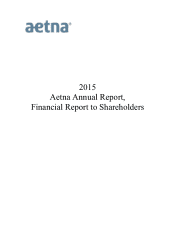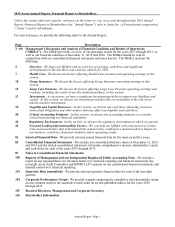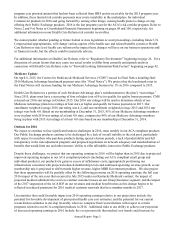Aetna 2015 Annual Report Download - page 11
Download and view the complete annual report
Please find page 11 of the 2015 Aetna annual report below. You can navigate through the pages in the report by either clicking on the pages listed below, or by using the keyword search tool below to find specific information within the annual report.Annual Report- Page 5
program year prorated amount that had not been collected from HHS and no receivable for the 2015 program year.
In addition, these limited risk corridor payments may create instability in the marketplace for individual
Commercial products in 2016 and going forward by, among other things, causing health plans to change or stop
offering their Public Exchange products. 2016 is the last program year for the ACA’s risk corridor program. Refer to
Notes 2 and 9 of Notes to Consolidated Financial Statements beginning on pages 88 and 109, respectively, for
additional information on our Health Care Reform risk corridor receivables.
We cannot predict whether pending or future federal or state legislation or court proceedings, including future U.S.
Congressional appropriations, will change various aspects of the health care and related benefits system or Health
Care Reform or state level health care reform or the impact those changes will have on our business operations and/
or financial results, but the effects could be materially adverse.
For additional information on Health Care Reform, refer to “Regulatory Environment” beginning on page 26. For a
discussion of certain factors that may cause our actual results to differ from currently anticipated results in
connection with Health Care Reform, refer to “Forward-Looking Information/Risk Factors” beginning on page 42.
Medicare Update
On April 6, 2015, the Centers for Medicare & Medicaid Services (“CMS”) issued its Final Notice detailing final
2016 Medicare Advantage benchmark payment rates (the “Final Notice”). We project that the benchmark rates in
the Final Notice will increase funding for our Medicare Advantage business by 1% in 2016 compared to 2015.
Health Care Reform ties a portion of each Medicare Advantage plan’s reimbursement to the plan’s “star ratings.”
Since 2015, plans must have a star rating of four or higher (out of five) to qualify for quality bonus payments. CMS
released our 2016 star ratings in October 2015. Our 2016 star ratings will be used to determine which of our
Medicare Advantage plans have ratings of four stars or higher and qualify for bonus payments in 2017. Our
enrollment weighted average 2016 star rating was 4.2, and our enrollment weighted-average 2015 and 2014 star
ratings were both 4.0. Based on our membership at December 31, 2015, 85% of our Medicare Advantage members
were in plans with 2016 star ratings of at least 4.0 stars, compared to 84% of our Medicare Advantage members
being in plans with 2015 star ratings of at least 4.0 stars based on our membership at December 31, 2014.
Outlook for 2016
We expect to continue to face significant business challenges in 2016, most notably in our ACA compliant products.
Our Public Exchange products continue to be challenged by a lack of overall stability in the risk pool, particularly
with respect to members who purchase products during special election periods; a lack of predictability and full
transparency in the risk adjustment program; and proposed regulations on network adequacy and standardization of
benefits that would limit our and other insurers’ ability to offer affordable, innovative Public Exchange products.
Despite these challenges, we project that our operating earnings in 2016 will be higher than in 2015 due to projected
improved operating margins in our ACA compliant products (including our ACA compliant small group and
individual products), net productivity gains in excess of inflationary costs, appropriately positioning our
infrastructure consistent with projected reduced membership levels and continued operating revenue growth, as our
membership mix is projected to shift towards higher revenue, higher MBR Government products. We also project
that these opportunities will be partially offset by the following pressures on 2016 operating earnings: the full year
2016 impact of the rate reset that occurred in July 2015 under our Kentucky Medicaid contract; the impact of
projected medical administrative services contract customer losses on our Group Insurance segment; and the impact
of the 2017 suspension of the ACA HIF on our revenues and medical benefit ratios as this change begins to be
reflected in reduced premiums for 2016 medical customer renewals that have member months in 2017.
Uncertainties that could favorably impact our 2016 operating earnings relative to our projections include: the
potential for favorable development of prior period health care cost estimates; and the potential for our current
reconciliation estimates to develop favorably when we complete final reconciliations with respect to certain
programs related to our ACA-compliant products in 2016. Additional risks to our ability to achieve our projection
of increased operating earnings in 2016 include: the ever present risk that medical cost trends could increase by
























